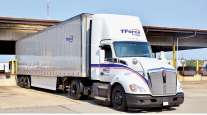Fleets Turn Attention to Driver Lifestyle

[Ensure you have all the info you need in these unprecedented times. Subscribe now.]
At a time when attracting and retaining professional truck drivers has become more difficult than ever, fleets are thinking differently about this persistent industry challenge.
To better compete in this tough labor market, trucking companies are not only raising driver pay, but also taking steps to enhance drivers’ lifestyles and provide a more favorable work-life balance.
“Drivers are more in demand than I’ve ever seen in my career,” said Chad England, CEO of refrigerated carrier C.R. England. “It makes it that much more important for great companies to continuously improve and have the type of culture people want to be a part of.”
Salt Lake City-based C.R. England, which ranks No. 25 on the Transport Topics Top 100 list of the largest for-hire carriers in North America, has been crafting its jobs differently to help maximize home time.
“Now we are up to 75% of our jobs in a dedicated scenario, local type of work or set runs in our over-the-road group. Those have home time of one degree or another,” England said.
In addition to increasing home time, many fleets have been shifting toward shorter length of haul, implementing driver pay increases and offering increased comforts while out on the road.

C.R. England has adjusted its operations to provide more home time for its drivers. (C.R. England)
“Based on a recent survey of our employees, current and incoming drivers expect job security, work-life balance, and fair and stable compensation,” said Greg Hodgen, CEO of bulk hauler Groendyke Transport.
Groendyke offers over-the-road positions that require drivers to be away from home for less than a week, on average, as well as regional and local work where drivers can be home on a daily basis.
The company communicates with its drivers to discuss their expectations and then works to meet their needs.
“It may need to change over time, so we revisit and try to accommodate drivers’ needs when life changes occur,” Hodgen said.
Enid, Okla.-based Groendyke ranks No. 96 on the for-hire TT100.
Jerry Sigmon Jr., chief operating officer at Cargo Transporters, said drivers’ desire for home time has increased during the COVID-19 pandemic.
“For our younger drivers and those with families, home time ranks up there with pay,” he said.
To better support drivers’ requests, the truckload carrier is focusing on freight in specific lanes that enable drivers to travel through their hometowns.
“We’ve found we’re better able to take care of the drivers if we have them in the areas where we have the high lane density,” Sigmon said.
See the 2021 Top 100 rankings
►Top 100 For-Hire Interactive Map
►Pandemic, Acquisitions Shake Up Top 100 List
►Trucking: From Pandemic to Prosperity?
►An Inside View of TT’s Sector Rankings
Sector Rankings
LTL | TL/Dedicated
Intermodal/Drayage
Motor Vehicle/Driveaway
Tank/Bulk | Air/Expedited
Refrigerated | Flatbed/HS
Package/Courier | Mail
Household Goods/Commercial
Coordinating trips home can take extra planning, “but we’re willing to do that if it makes it worthwhile,” Sigmon said, adding that the majority of Cargo Transporters’ drivers are home for their 34-hour restarts under federal hours-of-service rules.
“We have some that want to run more or run the weekends, and some drivers that want to stay out for two weeks at a time,” he said. “We have enough freight right now to let us take care of those driver needs.”
Cargo Transporters also is reexamining its average length of haul.
“We were in that 400- to 425-mile range, but we’re starting to see some opportunities in the 300 range,” Sigmon said.
Liquid bulk carrier Carbon Express’ goal is for drivers to travel 250 miles out and then come back, an approach that enables most drivers to return home daily.
Some drivers prefer to be out longer, but the fleet doesn’t utilize sleeper tractors. Instead, the company rents motel rooms for its drivers to improve comfort and rest, said Steve Rush, CEO of the Wharton, N.J.-based fleet.
“Our average monthly motel bill for 60 trucks is $40,000 a month,” he said.
In addition, Carbon Express charges customers more for weekend work.
“We’ll pick it up on Friday, but if you want it there on Monday, we want a premium,” Rush said, explaining that the driver isn’t getting home for a reset. “These are long and hard lessons for our industry, and they need to start happening.”
RELATED: C.R. England Announces Historic Driver Pay Increase
Rush said federally mandated electronic logging devices and hours-of-service rules have helped prioritize drivers’ needs.
“For the first time since Jimmy Hoffa, the drivers have an interest in the game,” Rush said, describing ELDs and HOS as the new Hoffa. “I believe the new Jimmy Hoffa is here, and he isn’t going away.”
Groendyke’s Hodgen agreed that ELDs have improved drivers’ lifestyles.
“Our drivers tell us they feel they have more control over their sleep patterns and feel more rested,” he said, adding that ELDs have forced planners to better understand what is feasible under HOS limits.
Although higher pay can attract drivers, more must be done across the transportation industry, Hodgen said.
“We need shippers, consignees, carriers and even the general public to hold drivers in the high esteem they deserve, both in words and actions,” he said.
Driver Productivity and Pay
Some fleets are focusing on no-touch freight to help optimize drivers’ productivity and pay.

American Central Transport drivers smile during a company cookout. (American Central Transport)
American Central Transport provides drop-and-hook jobs in which drivers do not need to wait for loading and unloading.
“Drop and hook honors their hours and gets pay much more consistent,” said Phil Wilt, president of the Kansas City, Mo.-based dry van truckload carrier.
ACT also has become more disciplined in its lanes to maximize home time.
“If we can get high concentrations in six major cities, we can triangulate and move drivers faster,” Wilt said.
Many fleets have been raising driver compensation directly.
C.R. England, for example, has implemented several recent increases, including its largest percentage overall pay increase in company history.
“When we have the opportunity to reposition the truck driving job and really pay drivers like the professionals that they are, we do it,” England said.
Fleets also are welcoming driver feedback to address their concerns and further improve their lifestyles.
C.R. England’s management is accessible to drivers through “town hall” and face-to-face meetings and video chats.
“We’ve made dozens of changes just by listening to our drivers,” England said.
To help improve drivers’ experiences, ACT collects driver feedback anonymously and in person, such as during its monthly cookouts.
“If you collect feedback, you have to respond to it,” Wilt said, adding that if a customer is disrespectful to a driver, management addresses it.

ACT has installed a truck swap-out station to make it easier for drivers to move their belongings into a new truck. (American Central Transport)
“The goal isn’t to fire the customer,” he said. “The goal is to collaborate with them and help them understand. Now is the time to get things right.”
Even little things can go a long way toward making drivers’ lives easier, Wilt said.
ACT allows drivers to bring along dogs and also offers “rider passes.”
“It is a big deal for the drivers to bring their kids around and let them meet everyone,” Wilt said.
ACT has a nurse to work with drivers on diet or lifestyle changes as well as chaplains who come in regularly and are available to assist drivers around the clock.
The fleet also recently installed a truck swap-out station to make it more convenient for drivers to move into a new tractor.
“They can walk back and forth on a platform instead of climbing up and down with their things,” Wilt said.
Cargo Transporters operates late-model equipment and has added in-cab driver comforts such as refrigerators and satellite TV and radio.
Sigmon said shippers also can do their part to improve drivers’ experiences by allowing them to park at their facilities.
“I understand space is a problem anywhere,” he said, “but if shippers and receivers will let drivers park on site, that helps them so much.”
Want more news? Listen to today's daily briefing below or go here for more info:





